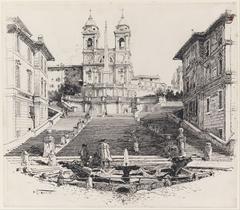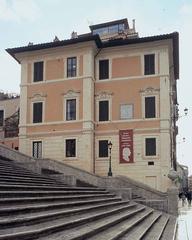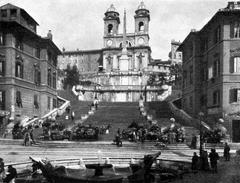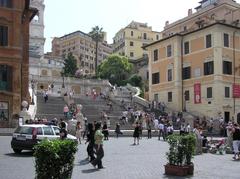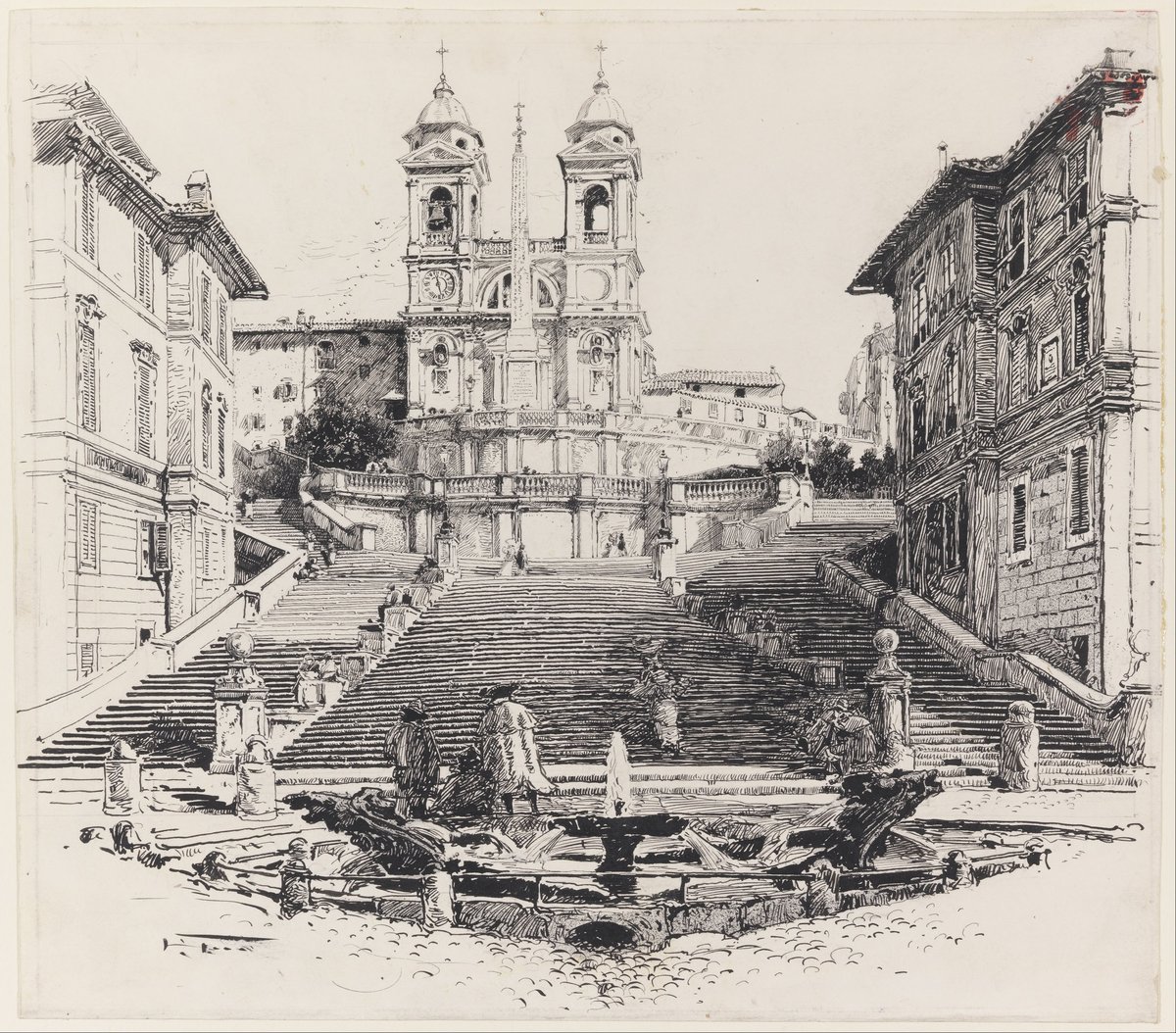
Keats-Shelley Memorial House Rome: Visiting Hours, Tickets, and Complete Guide
Date: 14/06/2025
Introduction
Nestled beside the iconic Spanish Steps at Piazza di Spagna 26, the Keats-Shelley Memorial House in Rome is a literary sanctuary dedicated to two of the English Romantic era’s most celebrated poets: John Keats and Percy Bysshe Shelley. This evocative 18th-century building is the very place where Keats spent his final months in 1821, and since 1909, it has served as a museum, library, and vibrant cultural center. With its rich collections of manuscripts, letters, rare books, artworks, and personal relics, the museum offers an immersive experience for literature enthusiasts and travelers alike, keeping the spirit of Romantic poetry alive through exhibitions, readings, and educational programs (Keats-Shelley House Official Site; Wanted in Rome; The Culture Map; Rome.net).
Contents Overview
- Introduction
- History and Significance
- Visiting Information
- Opening Hours
- Ticket Prices
- Accessibility & Guided Tours
- Directions & Nearby Attractions
- Photography Policy
- Museum Experience & Collections
- Special Events and Exhibitions
- Practical Tips for Visitors
- FAQ
- Conclusion
- Sources
History and Significance
Origins and Literary Legacy
The Keats-Shelley Memorial House occupies the rooms where John Keats, battling tuberculosis, lived his final months with companion Joseph Severn, passing away in February 1821 at age 25. The building’s transformation into a museum in 1909 was the result of a transnational effort by English, American, and Italian admirers, including the American poet Robert Underwood Johnson. This act of commemoration reflects the enduring appeal of the Romantic poets and their ideals (Keats-Shelley House; Wikipedia).
Percy Bysshe Shelley’s sojourns in Rome (1818–1822) were marked by both creative triumphs—writing “Prometheus Unbound” and “Adonais” (an elegy for Keats)—and personal losses, including the death of his son William, buried in the nearby Non-Catholic Cemetery, where Shelley himself would be interred after his drowning in 1822 (Wanted in Rome; The Culture Map).
The museum’s collection also honors other key Romantic figures—Lord Byron, Mary Shelley, Leigh Hunt—and highlights the cosmopolitan nature of the movement, especially its deep Anglo-Italian connections.
Wartime Preservation
During World War II, the museum’s staff removed external signage and concealed its most precious artifacts at the Abbey of Monte Cassino to protect them from Nazi destruction. These treasures were safely returned after Rome’s liberation in 1944 (My Adventures Across the World; Wikipedia).
Visiting Information
Opening Hours (as of June 2025)
- Standard: Monday–Saturday, 10:00 AM – 1:00 PM & 2:00 PM – 6:00 PM (last entry 5:45 PM)
- Closed: Sundays and select holidays
- Note: Hours may vary during special events and public holidays. Always check the official website before visiting.
Ticket Prices
- Adults: €6
- Youths under 18 / Seniors over 65: €5
- Children under 6: Free
Tickets are available for purchase on-site. Online sales may be introduced; check the official website for updates (Rome.net).
Accessibility & Guided Tours
- Accessibility: Due to the historic nature of the building, wheelchair access is limited. Contact the museum ahead of your visit for assistance (Turismo Roma).
- Guided Tours: While regularly scheduled tours are not standard, knowledgeable staff are available to answer questions, and educational panels are provided in English and Italian. Library access for researchers is by appointment.
Directions & Nearby Attractions
- Address: Piazza di Spagna 26, 00187 Rome, Italy
- Metro: Spagna (Line A)
- Bus: Several routes stop at Piazza di Spagna
- On Foot: Steps from the Spanish Steps and within walking distance of Trevi Fountain (550 meters), Piazza Barberini, and Piazza Colonna
Nearby Attractions:
- Spanish Steps & Trinità dei Monti Church
- Villa Borghese Gardens & Galleria Borghese
- Via Condotti shopping street
- Non-Catholic Cemetery (where Keats, Shelley, and Joseph Severn are buried) (My Adventures Across the World)
Photography Policy
- Photography is generally permitted without flash. Tripods and filming may be restricted to protect fragile items; always ask at the entrance.
Museum Experience & Collections
Atmosphere & Layout
The museum occupies the second floor of the building, with rooms preserved to evoke the early 19th-century ambiance. The intimate scale, dark wood paneling, and subdued lighting create a contemplative environment, inviting quiet reflection on the poets’ lives and works (The Culture Map; Turismo Roma).
Highlights of the Collections
- Keats’s Room: The room where Keats died remains a memorial, with his death mask, a lock of hair, and portraits by Joseph Severn. Original furnishings were destroyed due to health regulations; a reproduction bed is displayed (Fodor’s; English History).
- Manuscripts and Letters: Around 400 autograph manuscripts and letters by Keats, Shelley, Byron, and others, with many digitized for global access (Keats-Shelley House Digital Collections).
- Library: Over 8,000 volumes, including rare first editions, annotated works, and critical studies.
- Artworks and Relics: Portraits, busts (such as a bust and bone fragments of Shelley), Byron’s Venetian carnival mask, and T-yong Chung’s sculptures inspired by “Ode to a Nightingale.”
- Cinema Room: Small screening space with documentaries on the poets’ lives and historical context.
Temporary Exhibitions and Contemporary Art
Current and recent exhibitions include themes such as “The Spanish Steps, Revisited” and “Byron 200: A Digital Exhibition,” linking Romanticism to contemporary art and culture (Keats-Shelley House Official Events).
Special Events, Education, and Digital Resources
- Events: Poetry readings, literary lectures, and workshops are held regularly, especially during major anniversaries (e.g., Byron’s bicentenary in 2025) (Roma Pass).
- Education: The museum hosts over 400 school groups annually and supports scholarly research.
- Digital Collections: Extensive online archives and virtual tours expand access for global audiences.
Practical Tips for Visitors
- Visit Duration: Plan for 30 minutes to 1.5 hours, depending on your interest.
- Quiet Times: Early mornings and late afternoons are less crowded.
- Gift Shop: Offers books, prints, literary-themed gifts, and exclusive merchandise.
- Souvenirs: Purchases support museum preservation and education.
- Accessibility: Contact ahead for mobility support; some areas may be challenging.
Frequently Asked Questions (FAQ)
Q: Can I buy Keats-Shelley Memorial House tickets online?
A: Currently, tickets are purchased on-site. Check the official website for future online sales.
Q: What are the visiting hours?
A: Monday–Saturday, 10:00 AM–1:00 PM & 2:00 PM–6:00 PM. Closed Sundays.
Q: Is the museum wheelchair accessible?
A: Accessibility is limited; contact the museum in advance for details.
Q: Are guided tours available?
A: Regular tours are not scheduled, but staff can assist with questions; researchers can arrange library visits by appointment.
Q: Can I take photographs?
A: Yes, non-flash photography is allowed, with restrictions on tripods and filming.
Conclusion
The Keats-Shelley Memorial House is a sanctuary for poetry lovers and cultural explorers, providing an intimate connection to the Romantic era’s greatest voices. Its historic rooms, evocative collections, and ongoing commemorative events make it a must-visit among Rome’s literary and historical attractions. For current information on tickets, hours, events, and digital resources, visit the Keats-Shelley House Official Site.
Enhance your visit with the Audiala app, offering curated guides and insider tips for Rome’s literary landmarks.
Sources and Further Reading
- Keats-Shelley House Official Site
- The Culture Map
- Keats-Shelley House Digital Collections
- Rome.net
- Wanted in Rome
- Roma Pass
- Fodor’s
- English History
- My Adventures Across the World
- Turismo Roma
- Wikipedia
